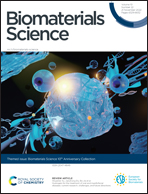Hydrogels for the treatment of oral and maxillofacial diseases: current research, challenges, and future directions
Abstract
Oral and maxillofacial diseases such as infection and trauma often involve various organs and tissues, resulting in structural defects, dysfunctions and/or adverse effects on facial appearance. Hydrogels have been applied in the treatment of oral diseases and defect repair due to their three-dimensional network structure. With their biocompatible structure and unique stimulus-responsive property, hydrogels have been applied as an excellent drug-delivery system for treatments that mainly include oral mucosal diseases, wounds, periodontitis and cancer therapy. Hydrogels are also ideal scaffolds in regenerative engineering of dentin–pulp complex, periodontal tissue, bone and cartilage. This review discusses the fundamental structure of hydrogels in brief and then focuses on the characteristics and limitations in current research and applications of hydrogels. Finally, potential future directions are proposed.



 Please wait while we load your content...
Please wait while we load your content...